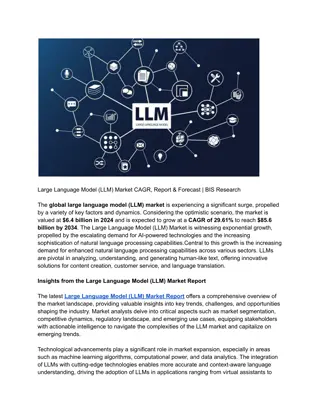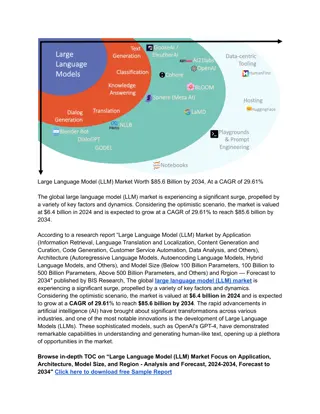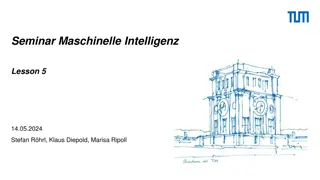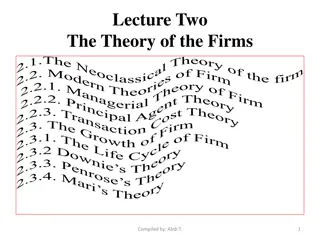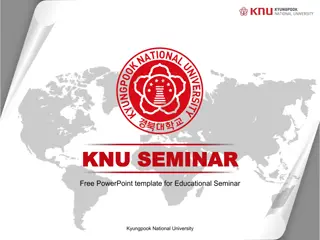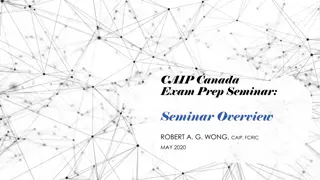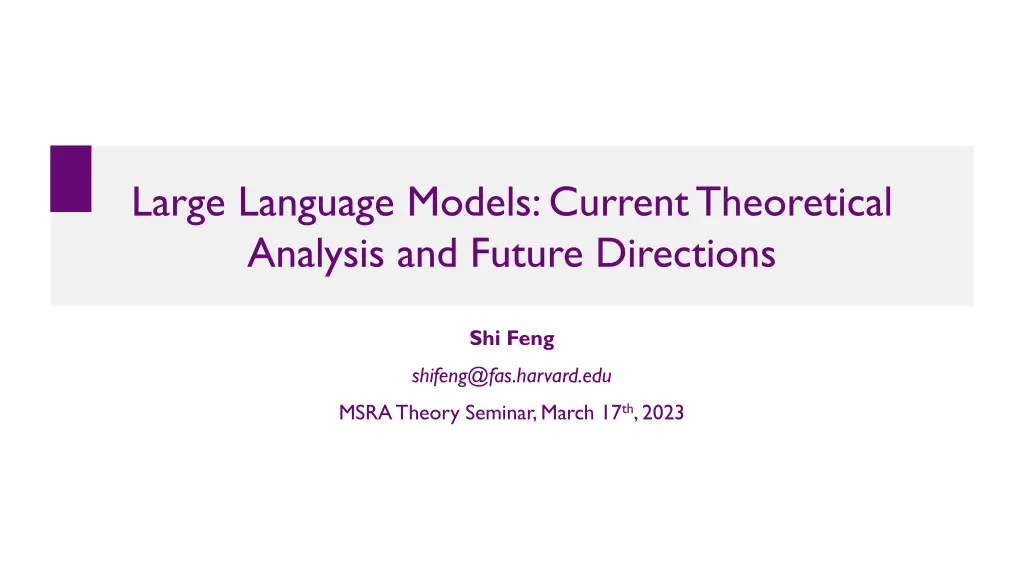
Theoretical Analysis of Large Language Models
Explore the two levels of theory on Large Language Models (LLMs), discussing their limitations and emergent abilities. Delve into practical challenges faced by pretrained LLMs and the gap between theoretical analysis and real-world performance. Discover the insights on transformers' ability to solve PARITY and the impact of attention mechanisms on their capabilities. Dive into representative works and future directions in understanding LLMs' reasoning abilities.
Download Presentation

Please find below an Image/Link to download the presentation.
The content on the website is provided AS IS for your information and personal use only. It may not be sold, licensed, or shared on other websites without obtaining consent from the author. If you encounter any issues during the download, it is possible that the publisher has removed the file from their server.
You are allowed to download the files provided on this website for personal or commercial use, subject to the condition that they are used lawfully. All files are the property of their respective owners.
The content on the website is provided AS IS for your information and personal use only. It may not be sold, licensed, or shared on other websites without obtaining consent from the author.
E N D
Presentation Transcript
Large Language Models: Current Theoretical Analysis and Future Directions Shi Feng shifeng@fas.harvard.edu MSRA Theory Seminar, March 17th, 2023
Contents Two Levels of Theory on LLMs Theoretical Limitations of LLMs (data-free) EmergentAbility of LLMs (data-based) My Thoughts on Emergent Reasoning Ability
Two Levels of Theory on LLMs There are two emergent lines of research on the theory aspects of large language models (LLMs). Data-FreeTheoretical Analysis: A typical question: regardless of the training data and training process, what is the limitation of underlying models (i.e., transformer) of LLMs? A representative work: Hahn M. Theoretical limitations of self-attention in neural sequence models. ACL 2020. Data-BasedTheoretical Analysis: A typical question: why/how pretrained LLMs could do these amazing things? A representative work: Nanda N, Chan L, Liberum T, et al. Progress measures for grokking via mechanistic interpretability. ICLR 2023.
There is a huge gap between these two levels! One could use looped transformer to construct a Turing machine (GiannouA, et al. Looped Transformers as Programmable Computers. arXiv:2301.13196.). However, practical pretrained LLMs make mistakes even on some simple arithmetic tasks. That is to say, limitations of training data and method may constrain the power of LLMs.
Contents Two Levels of Theory on LLMs Theoretical Limitations of LLMs (data-free) EmergentAbility of LLMs (data-based) My Thoughts on Emergent Reasoning Ability
Transformers for PARITY Can t Can Empirically (data-based), transformers cannot be trained to solve PARITY [Bhattamishra, 2020] In the data-free setting, transformers using softmax(soft)-attention can recognize PARITY [Chiang et al., 2022] In the data-free setting, transformers using argmax(hard)-attention cannot recognize PARITY [Hahn, 2020] By adding layer normalization, transformers using softmax(soft)-attention can recognize PARITY with low cross-entropy [Chiang et al., 2022] In the data-free setting, transformers using softmax(soft)-attention cannot recognize PARITY with low cross-entropy [Hahn, 2020] Related Papers: Bhattamishra, Satwik, Kabir Ahuja, and Navin Goyal. "On the ability and limitations of transformers to recognize formal languages." arXiv preprint arXiv:2009.11264 (2020). Hahn, Michael. "Theoretical limitations of self-attention in neural sequence models." Transactions of the Association for Computational Linguistics 8 (2020): 156-171. Chiang, David, and Peter Cholak. "Overcoming a Theoretical Limitation of Self-Attention." Proceedings of the 60th Annual Meeting of the Association for Computational Linguistics (Volume 1: Long Papers). 2022.
Hard-Attention Transformers for PARITY In the data-free setting, transformers using argmax(hard)-attention cannot recognize PARITY [Hahn, 2020] The proof of this result is complex, so we will only provide a few key insights. The transformer can be viewed as an extension of a Boolean circuit, allowing us to apply techniques from circuit complexity theory. Hard-attention means that each node is almost uniquely determined by a single node in the previous layer, resulting in a sparse graph structure. The proof does not depend on the specific activation function or parameters used, so the crucial point is that circuit complexity techniques can be applied to the hard-attention transformer s unique graph structure.
Soft-Attention Transformers for PARITY In the data-free setting, transformers using softmax(soft)-attention cannot recognize PARITY with low cross-entropy [Hahn, 2020] Proof Insights: the impact of any single input symbol on the output of the transformer is small if the input is long. In the data-free setting, transformers using softmax(soft)-attention can recognize PARITY [Chiang et al., 2022] Construction: Using ?? ? = (? ?, cos(??)) positional encoding. 1. Compute ?/? (using uniform attention) 2. Activate position ? 3. Test whether position ? is odd (two attention heads, one attends more to even positions, one odd )
Soft-Attention Transformers for PARITY By adding layer normalization, transformers using softmax(soft)-attention can recognize PARITY with low cross-entropy [Chiang et al., 2022] LayerNorm(?)=(?-mean(?))/std(?), Lemma 5 in [Hahn, 2020] requires Lipschitz-continuous prediction functions, butLayerNormis not. Another method to overcome Lemma 5 in [Hahn, 2020]: log-length scaled attention Redefine attention as: Then exists a transformer that can recognize FIRST with low cross-entropy.
Some Personal Thoughts This burgeoning line of research is come from theory of computation especially Boolean circuit. One who is interested in this topic could refer to related work section of [Chiang et al., 2023]. An overview of results: I don t personally work on this topic because there is another line of work on transformers with memory (or tape)that pushes their theoretical computational power to a high level. Related Paper: Chiang, David, Peter Cholak, and Anand Pillay. "Tighter Bounds on the Expressivity of Transformer Encoders." arXiv preprint arXiv:2301.10743 (2023).
Construct Computing Machine Using Transformer Turing Machine [Perez et al., 2021] The class of Transformer networks with positional encodings is Turing complete. In detail, they construct a transformer with a single layer encoder and a three layers decoder using positional encodings ??? ? = ?,1 ?, An interesting justification for positional encoding: order-invariance. 1 ?2 to emulate Turing machine. Here, PropInv ? = {? |prop ?,? = prop ?,? for every ? }, prop is the proportion of a symbol in an expression. Using Proposition 3 in [Perez et al., 2021], it is easy to prove that ? = { } ?,? | ? has an even number of ? symbols cannot be recognized by a transformer. ? Related Paper: P rez, Jorge, Pablo Barcel , and Javier Marinkovic. "Attention is turing complete." The Journal of Machine Learning Research 22.1 (2021): 3463-3497.
Construct Computing Machine Using Transformer Programmable Computer [Giannou et al., 2023] There exists a looped transformer with less than 13 layers that can emulate ageneral purpose computer (using SUBLEQ), a basic calculator, numerical linear algebra methods, such as approximate matrix inverse and power iteration, and in-context learning algorithms, such as SGD, on neural networks. Intuition: use a predefined (data-free) transformer called transformer-based function block (FLEQ) to realize SUBLEQ. Related Paper: Giannou, Angeliki, et al. "Looped Transformers as Programmable Computers." arXiv preprint arXiv:2301.13196 (2023).
Some Personal Thoughts It s not surprising that the computing power of transformers is equivalent to that of classical computers. By making modifications to the transformer structure, we can usually increase its power to perform computational tasks. This may partially explain why transformers are used in many research areas such as natural language processing and computer vision. However, theoretical computing power artificial intelligence! Therefore, data-based theory research should be conducted to more specifically understand how large language models like GPT-4 can perform amazing tasks and how they can be improved.
Contents Two Levels of Theory on LLMs Theoretical Limitations of LLMs (data-free) EmergentAbility of LLMs (data-based) My Thoughts on Emergent Reasoning Ability
A Brief Introduction of Emergent Abilities Definition in [Wei et al., 2020]: an ability to be emergent if it is not present in smaller models but is present in larger models. Few-Shot Prompted Tasks: Augmented Prompting Strategies: multi-step reasoning (chain-of-thought prompting), instruction following (use instructions to describe a task), program execution (8-digit addition), model calibration, etc. Related Paper: Wei, Jason, et al. "Emergent abilities of large language models." arXiv preprint arXiv:2206.07682 (2022).
Emergent Ability of Few-Shot Prompted Tasks 1021 1023 seems like the threshold for most tasks!
Emergent Ability of Augmented Prompting Strategies Also have obvious emergent ability!
Potential Explanation 1 When the model is small, it may not be able to encode complex knowledge into its parameters or simply ignore subtle knowledge. However, as the number of model parameters increases or the training epoch progresses, the model may become better equipped to encode this knowledge. An example task: modular addition [Nanda et al., 2023]. They did reverse engineering on a one-layer transformer and used periodicity of neuron activations and some other validations to prove the following embedded algorithm.
Potential Explanation 1 When the number of training epoch increases, the embedded algorithm is changed from simple memorization (epochs 0-1.4k) to circuit formation (epochs 1.4k-9.4k) and then cleanup (epochs 9.4k- 14k). 0-1.4k memorization: test and restricted loss both remaining high and the Gini coefficient staying relatively flat. 1.4k-9.4k circuit formation: excluded loss rises, sum of squared weights falls, restricted loss starts to fall, and test and train loss stay flat. 9.4k-14k cleanup: excluded loss plateaus, restricted loss continues to drop, test loss suddenly drops, and sum of squared weights sharply drops. Restricted loss is the loss of the intermediate model can use only frequencies ? in the final network. Excluded loss is the loos of the intermediate model can only use the rest of frequencies. Related Paper: Nanda, Neel, et al. "Progress measures for grokking via mechanistic interpretability." arXiv preprint arXiv:2301.05217 (2023).
Potential Explanation 2 Some applications, such as multi-step reasoning, require the integration of knowledge from different domains. Such integration could be modeled by connectivity in graph theory. Random networks can exhibit emergent behaviors when the edge probability exceeds a threshold and a giant component emerges. Hence, emergence behaviors in random networks may also explain emergent ability of LLMs for some specific applications.
Contents Two Levels of Theory on LLMs Theoretical Limitations of LLMs (data-free) EmergentAbility of LLMs (data-based) My Thoughts on Emergent Reasoning Ability
Potential Explanation 2 I wrote a toy model for multi-step reasoning. There is an underlying directed knowledge graph ? as the ground truth. A multi-step reasoning is successful if and only if it is a legal directed path in ?. A node contains a set of synonyms or a set of similar concepts. A LLM ? maps concepts or expressions into embedding vectors by ?. We create a knowledge graph ? for ?. If two concepts ? and ? have similar embedding vectors, i.e., ?(?) ?(?), we put them into a single node of ? . We also have a decoder ? in ? which takes all previous concepts as the input and the next concept as output. Two nodes ?,? in ? are connected if and only if ? has a 1 ? probability taking concepts in ? as a feasible result of concepts in ?. When the connectivity of ? is close to the ground truth ?, the LLM ? has emergent ability. ? is nearly a random network and therefore we conjecture it has phase transition with respect to the training accuracy.
Thank you! Shi Feng March 17th, 2023




